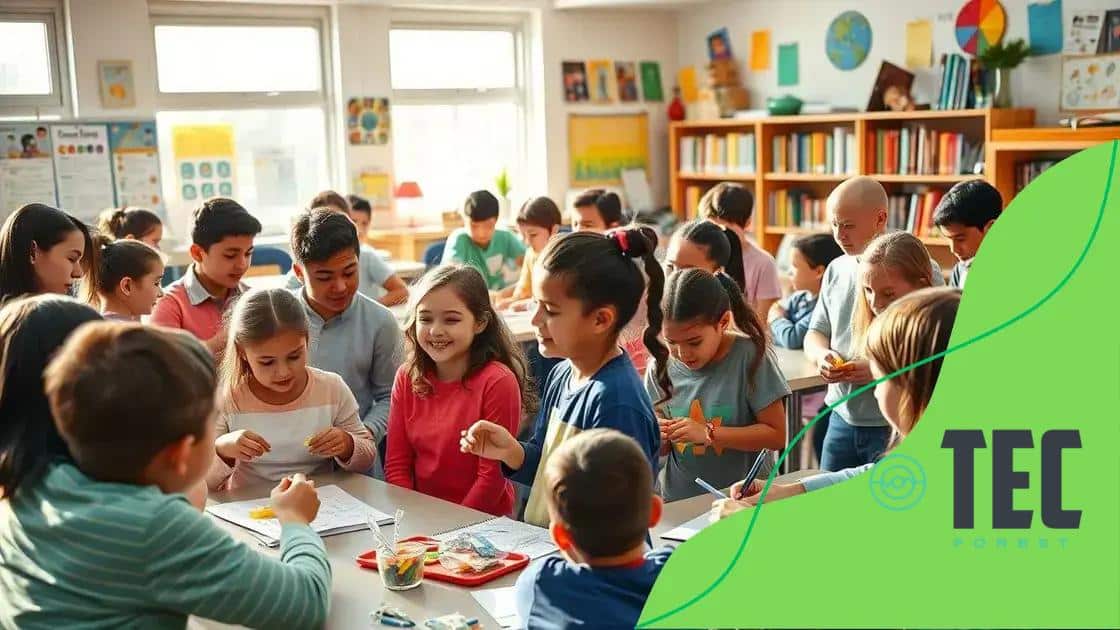Advertisement
The debate over letter grades versus mastery-based learning highlights a significant shift in education, emphasizing deep understanding and personalized learning over traditional grading metrics.
Debate over letter grades versus mastery-based learning is heating up as educators seek better ways to assess student progress. Have you ever wondered if traditional grades truly reflect student understanding? Let’s dive into this discussion.
Advertisement
Understanding letter grades: pros and cons
Understanding letter grades is essential to grasp the ongoing debate over letter grades versus mastery-based learning. Letter grades, ranging from A to F, have been a longstanding method of assessing student performance. However, this traditional system raises questions about its effectiveness and relevance in today’s educational landscape.
One of the significant advantages of letter grades is their clear and straightforward format. Students readily understand what a grade of A represents compared to a C. This simplicity can foster competition and encourage students to strive for excellence. However, many educators argue that this grading system does not capture the full extent of a student’s understanding or abilities.
Advertisement
Pros of letter grades
Letter grades serve multiple purposes in the academic setting:
- Standardization: They provide a common framework for schools and educators.
- Motivation: High-performing students often aim for higher grades as a goal.
- Quick feedback: Grades offer immediate insight into performance.
However, despite these benefits, letter grades can also have drawbacks. For example, some students may feel discouraged by a low grade, leading to a fixed mindset. This situation can stifle their willingness to learn and improve. Concerns also arise over how grades can be subjective, varying significantly between different teachers or schools.
Cons of letter grades
While they offer clarity, letter grades can also contribute to a range of issues:
- Pressure: Students may experience stress and anxiety over grades.
- Limited feedback: Grades do not explain specific areas for improvement.
- Neglect of non-academic skills: Skills such as teamwork and creativity often go unassessed.
In conclusion, while letter grades offer clear benchmarks for student performance, they come with significant challenges that can impact students’ overall learning experience. Understanding these pros and cons is vital in shaping future educational practices.
What is mastery-based learning?

What is mastery-based learning? This educational approach focuses on ensuring that students achieve a high level of understanding before moving on to new material. Instead of progressing through a standardized curriculum based solely on time spent in class, mastery-based learning emphasizes demonstrating competence in a subject.
In this model, students take the necessary time to grasp critical concepts thoroughly. This often means they can revisit topics and practice until they feel confident in their knowledge. For instance, a student might spend extra time on fractions if they struggle, rather than advancing before they are ready.
Key features of mastery-based learning
There are several essential aspects that define mastery-based learning:
- Individualized learning pace: Students progress at their own speed, which helps cater to their unique learning needs.
- Focus on understanding: The goal is to achieve deep knowledge rather than just memorizing information for a test.
- Frequent assessments: Regular check-ins help ensure students are mastering the material before advancing.
Among the benefits, mastery-based learning can lead to increased student engagement. When learners know they can explore a topic until they fully understand it, they feel more in control of their education. This method also allows teachers to identify learning gaps early and provide targeted support.
Examples of mastery-based learning
Mastery-based learning can take various forms in the classroom:
- Project-based assessments: Students complete projects that require applying concepts in real-world situations.
- Adaptive learning technologies: Tools that adjust to each student’s level, providing tailored resources and feedback.
- Peer teaching: Students teach each other, enhancing understanding through collaboration.
Ultimately, mastery-based learning represents a shift from traditional grading systems. It aligns more closely with how students learn and grow over time, providing a supportive framework for their educational journeys.
Key differences between grading systems
When considering the key differences between grading systems, it’s essential to understand how they impact students and educators alike. Different systems approach assessment in unique ways that can influence learning outcomes. While traditional grading focuses on letter grades, newer systems look beyond mere scores.
One major difference lies in the approach to evaluation. Traditional grading often relies on a one-size-fits-all scale, whereas mastery-based systems prioritize a student’s understanding and skills before they advance. This means that students may have different paths tailored to their learning pace.
Traditional grading system
In a conventional grading system, students receive letter grades based on their performance. This can create a competitive environment, but it often does not reflect a student’s actual understanding.
- Standardized assessments: Tests and quizzes are the primary sources of grades.
- Focus on averages: Grades are averaged over the course of the term.
- Limited feedback: Students receive a single letter without detailed insights on their performance.
Although familiar, this system can lead to anxiety and may not encourage students to dig deeper into subjects they find challenging.
Mastery-based grading system
On the other hand, a mastery-based system evaluates students based on their ability to demonstrate knowledge and skills. This approach fosters a deeper level of learning.
- Flexible pacing: Students can progress as they master the material.
- Ongoing assessments: Frequent evaluations guide student learning continuously.
- Detailed feedback: Students receive constructive feedback on their strengths and areas for improvement.
This difference in focus allows students to develop a growth mindset, encouraging them to embrace challenges rather than fear failure. By understanding these key differences, schools can tailor their approach to support student learning effectively.
Impact on student motivation and engagement

The impact on student motivation and engagement is a crucial aspect of both grading systems and mastery-based learning. Understanding how these elements influence student attitudes can help educators create better learning environments. Traditional grading methods often contribute to a focus on achieving a specific letter instead of genuinely understanding the material.
This focus can lead to students feeling anxious or disengaged, as they may worry more about their grades than about learning. They might rush through assignments just to get a grade instead of pondering the actual concepts. However, a mastery-based approach tends to foster a more positive learning atmosphere.
Motivation in traditional grading systems
In traditional grading systems, motivation often hinges on external rewards. Students might push themselves to achieve high grades, but this can come at a cost:
- Pressure to perform: Many students feel overwhelmed by the need to maintain a high GPA.
- Fear of failure: Students may fear receiving low grades and losing opportunities.
- Shallow learning: The focus on grades may discourage deep exploration of subjects.
As a result, while students may push for high scores, they often do so without a genuine desire to learn. This mindset can lead to burnout and disengagement in the long run.
Motivation in mastery-based learning
Switching to a mastery-based model completely changes how motivation works. This approach encourages students to take ownership of their learning. With ongoing assessments and personalized feedback, students can see tangible progress:
- Increased autonomy: Students have the freedom to learn at their own pace.
- Focus on growth: Emphasis on improvement fosters a love for learning rather than just performing for grades.
- Positive feedback loops: Continuous feedback helps students feel supported and motivated.
Ultimately, students engaged in mastery-based systems are more likely to develop resilience and a lasting interest in their education. By focusing on understanding, they feel empowered to tackle challenges rather than avoiding them based on the fear of poor grades.
Future of education: trends and predictions
The future of education is evolving rapidly, influenced by technology and changing societal needs. As we look ahead, it’s essential to identify emerging trends and predictions that will shape learning experiences. Innovations are paving the way for a more personalized and engaging educational landscape.
One significant trend is the rise of technology in classrooms. More schools are adopting digital tools and resources, which enhance interactive learning. For instance, tools like virtual reality (VR) can transport students into different environments, making complex subjects more tangible and exciting.
Key trends shaping the future of education
Several key trends are expected to influence how we teach and learn:
- Personalized learning: Tailoring educational experiences to meet individual student needs is becoming increasingly popular. This approach allows students to learn at their own pace.
- Blended learning models: Combining online digital media with traditional in-person classroom methods is gaining traction. This flexibility can help accommodate different learning styles.
- Social-emotional learning: Schools are placing greater emphasis on mental health and emotional well-being. Teaching students how to manage feelings contributes to a supportive learning environment.
These trends are more than just passing fads; they reflect a fundamental shift in the way educators and institutions view learning. Another critical area is the integration of data analytics, which helps educators track student progress in real-time, allowing for timely interventions and personalized support.
Predictions for educational systems
As we envision the future, several predictions can be made about the direction of educational systems:
- Increased relevance of soft skills: Employers are looking for critical thinking, teamwork, and communication skills. Education will increasingly focus on developing these skills.
- Global learning environments: The classroom is no longer limited by geography. Virtual classrooms can connect students from different countries, promoting cultural exchange and collaboration.
- Greater emphasis on lifelong learning: As the job market continues to change, adults will need to continuously update their skills. Educational systems will support this need for ongoing growth.
As we adapt to these trends and predictions, both educators and students will shape a more dynamic and inclusive educational future. By embracing these changes, we can create learning environments that empower every learner to succeed.
In conclusion, the discussion on letter grades versus mastery-based learning highlights a crucial transition in education. Both grading approaches have unique impacts on student engagement and motivation. As we look to the future, integrating technology and tailored learning experiences will be essential for fostering a supportive and effective educational environment. Embracing these trends not only prepares students for academic success but also equips them with the skills needed for lifelong learning and personal growth.
FAQ – Frequently Asked Questions about the Debate Over Letter Grades and Mastery-Based Learning
What is mastery-based learning?
Mastery-based learning is an educational approach that focuses on ensuring students fully understand a subject before moving on, allowing for personalized learning.
How do letter grades affect student motivation?
Letter grades can create pressure and a fear of failure, leading some students to focus more on achieving high grades rather than on learning.
What are the benefits of a mastery-based system?
A mastery-based system promotes deeper understanding, reduces anxiety, and encourages students to take ownership of their learning.
How is technology shaping the future of education?
Technology enhances learning experiences by providing personalized resources, virtual classrooms, and tools for collaboration, making education more accessible.
